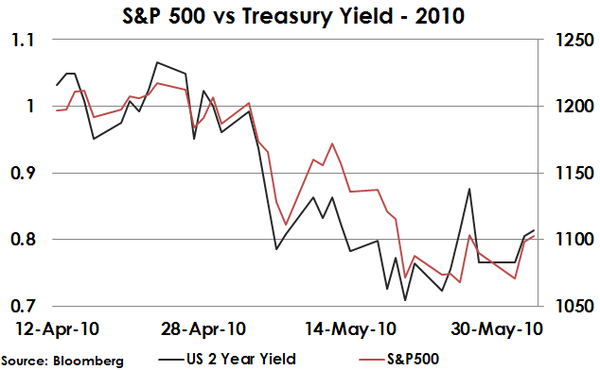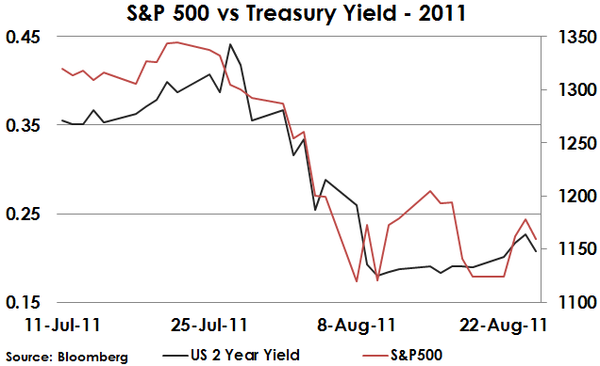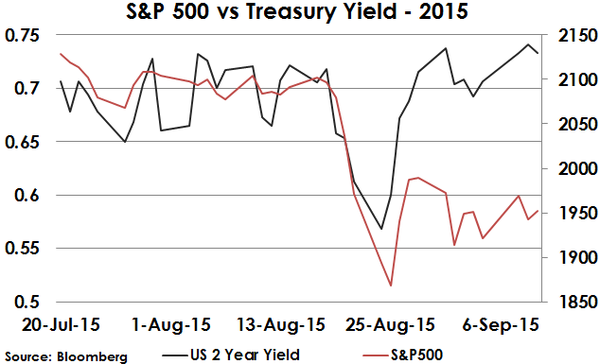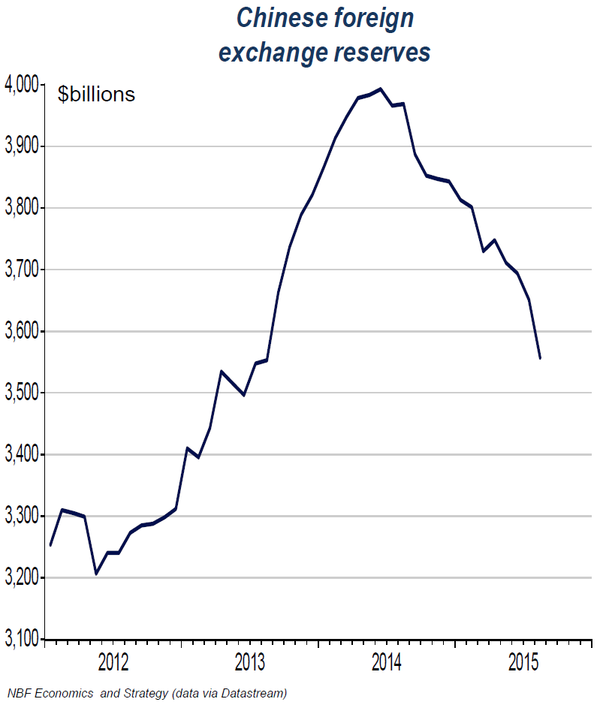Investors Are Losing Faith in the Fed
By Christine Hughes, Canada. Chief Investment Strategist, OtterWood Capital:
The recent market drop revealed a change in market dynamics that I find particularly troubling. Historically when the stock market crashes, U.S. Treasury bond prices tend to rise simultaneously (remember when bond prices increase, the yield decreases). The bond market loves when bad things happen because it drives investors into bonds out of fear and/or on expectations of lower economic growth.
The following charts show the close relationship between the 2-year yield and the S&P500 during three recent significant market selloffs, although the relationship goes back much longer.
Note how in each instance bond yields move down (bond prices up) in sympathy with the stock market selloff and stay down. In the history of our markets, we have never seen stock and bond prices drop together during a market selloff until a few weeks ago.
The relationship initially held when stocks fell but immediately after the market drop the 2-year yield jumped back to new highs. The cushion from yields was only momentary. I do not take this as a positive development for the markets.
Some commentators have pointed out that yields are increasing due to expectations the Fed’s will hike interest rates but this isn’t correct. In fact the federal funds futures market, which is used to estimate the probability of a Fed rate hike from current market prices, is only showing a 28% chance of liftoff next week.
Treasury yields are currently increasing for the wrong reasons; mainly large investors don’t want the bonds anymore and are selling. A couple of large holders come to mind, mainly China, and technical selling from black boxes like risk parity funds. As I’ve covered on our blog, which you can read here, China has been selling Treasuries to stabilize its currency. They have been selling their vast Treasury holdings since last year, check out the chart below.
The other factor dominating trading recently is risk parity funds. These funds have added selling pressure during market drops and aggravated the moves to the downside. See our post here for more information on these enormous funds.
This recent divergence between bonds and stocks is radical and is a knock to confidence in the financial system. An environment when bond and stock prices fall together is an indication that investors are losing faith in the Fed, the government and debt in general, which is a very negative development. In my video next week I will explain this whole phenomenon more fully. By Christine Hughes, OtterWood Capital
What we’re seeing is the beginning of a massive reserve unwind in China. Read… China’s Record Month
Enjoy reading WOLF STREET and want to support it? You can donate. I appreciate it immensely. Click on the mug to find out how:
![]()







Christine,
Perhaps if the FED had not distorted the real economy you could use historical references. The wonderful aspect of this new paradigm is you have no clue what is going to happen. my opinion is you are going to lose.
In the 70’s there was a horrendous bear market in the U.K. and interest rates rose to unbelievable levels at the same time. Bond prices, or what we used to call Gilt Edge (Gilts) collapsed at the same time as equity prices.
I am not sure about the U.S. at that time but I suspect the same trends were in place but to a far lesser extent.
Perhaps the actions of Neocons like Nuland & Obama towards Russia and Ukraine has triggered a concerted global effort to breakdown the almighty Petrodollar. We see Russia and China entering into huge energy trades that are accounted for without the dollar. Does this affect U. S. Treasury bond supply/demand pricing?
At the risk of repeating myself, the USA debt to GDP has grown to over 100%, and according to the CBO, it will stay there for decades! We are seeing a global economic slowdown, and when China sells Treasuries, where do the replacement buyers come from? Oh yeah, the Fed can print more paper for a short term stop-gap, but at some point the interest rates will have to go up.
Let’s say in a year or two we are at a $20 trillion national debt and a $18 trillion GDP, with a federal budget of just under $4 trillion and government revenue at $3.4 trillion. Now, let’s look at a potential scenario of 6% interest to carry that national debt, and you get a $1.2 trillion cost to simply run in place on a treadmill. In this scenario, both stocks and bonds would suffer … but heck, I’m no economist.
This economic recovery was not distorted by the federal reserve. However, the bull market in stocks was aided by the successive rounds of QE. Until the U.S. economy begins to falter, we will not enter into a bear market any time soon.